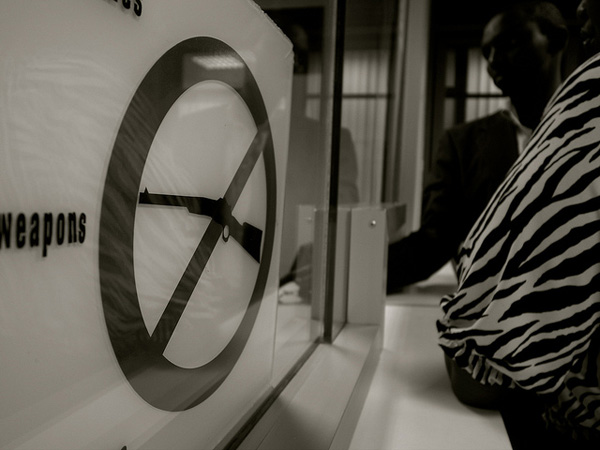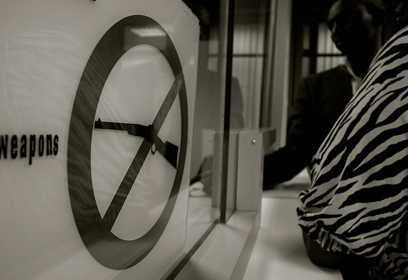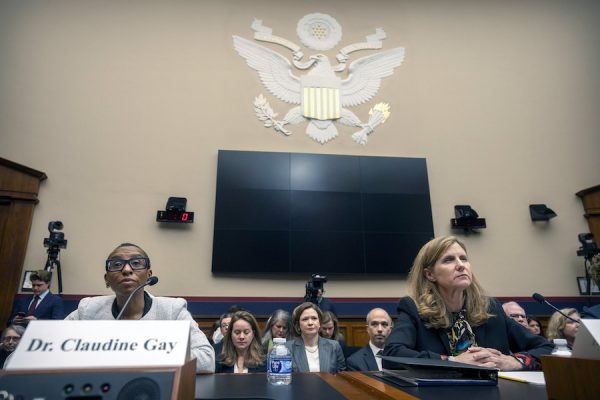
After his son Christopher was gunned down near the campus of the University of California, Santa Barbara on May 23, Richard Martinez sounded what has become a famous plea.
“Why did Chris die?” he asked, choking back tears. “Chris died because of craven, irresponsible politicians and the [National Rifle Association]. They talk about gun rights. What about Chris’s right to live?” He went on, “When will this insanity stop? . . . We don’t have to live like this.”
In response to Martinez’s impassioned appeal for gun control, the cavalcade of bumper-sticker slogans rolled in—“guns don’t kill people, people kill people,” “control criminals, not guns,” “don’t punish law abiding citizens,” and so on.
The NRA has been silent on the shooting, as is its usual media strategy following high-profile gun violence. But we know its position: the solution to gun violence is always more guns.
Thus the express goal of the NRA and other pro-gun groups is to promote the concealed carrying of firearms on college campuses. As the NRA puts it, “Colleges rely on colorful ‘no gun’ signs, foolishly expecting compliance from psychopaths.”
To this end, the NRA and state legislators are pushing guns at every level of schooling. The lobby backed a new Indiana law that allows guns on school property, so long as they are contained within parked cars.“Teachers have to leave their 2nd Amendment rights at the front door when they go to work,” said Indiana Senator Brent Steele, explaining why he supported the measure, in spite of the fact that the courts have never wavered on the constitutionality of gun bans on school property. A bill in Nebraska, if passed, would allow teachers and school employees to carry concealed handguns in schools. In Idaho Governor Butch Otter recently signed a law that allows residents with “enhanced concealed-carry permits” to keep firearms on college campuses. A similar bill passed a Florida Senate panel but ultimately was voted down.
The consistent refrain from conservative lawmakers and the gun lobby has been that such legislation will enhance security in schools. The logic is that if students and teachers are armed, or at least protected by armed guards, shootings such as those at Columbine High School in 1999, Virginia Tech in 2007, Sandy Hook Elementary School in 2012, UCSB, and, yesterday, Seattle Pacific University, either will not occur or will be less deadly.
Yet the evidence points in the opposite direction. Schools, including college campuses, exemplify the success of gun control. Though our schools are far deadlier than those of other countries with stricter gun control policies, they are safer than other corners of America that lack stringent constraints on guns.
How Safe Is School?
Despite the fact that the United States compares favorably to other high-income nations in terms of school bullying rates, we are the exception in terms of lethal school violence. The most comprehensive study of school shootings to date—encompassing thirty-eight countries between 1764 and 2009—found that the United States had one less mass shooting than all the other countries combined.
The disparity in lethal school violence between the United States and other countries is almost entirely a function of firearm prevalence. It is not a coincidence that, in the United States, the vast majority of mass killings are carried out with a firearm, while in China, which had the second highest rate of mass killings in the dataset, not a single one was carried out with a gun.
But while Americanschools may be less safe than their international counterparts, they are still among the safest places in the United States.
Schools are safer than other corners of America that lack stringent constraints on guns.
Among school-age children, less than 1 percent of homicides occur either on school grounds or on the way to school, even though far more than 1 percent of students’ time is spent in school and en route. A Justice Department study showed that, between 1995 and 2002, college students between the ages of eighteen and twenty-four experienced 24 percent less violence than non-college students in the same age group. When college students experienced violence, it occurred off-campus 93 percent of the time.
These sanguine statistics are a reflection of the near universal prohibition of firearms by academic institutions. At least thirty-eight states ban firearms on school grounds, and sixteen explicitly prohibit concealed carry on campus. Such policies enjoy massive public support: according to one survey carried out by researchers at the Harvard School of Public Health, 94 percent of Americans feel less safe when fellow citizens “bring their guns into restaurants, college campuses, sports stadiums, bars, hospitals, or government buildings” and “overwhelmingly, the public believes that in many venues gun carrying should be prohibited.”
So just what sort of effect would guns on school grounds have? For starters, we can be confident they would not decrease school violence.
Public Carrying Doesn’t Reduce Crime
One of the intellectual touchstones behind the pro-gun movement’s support for extending concealed carry permits to schools is John R. Lott’s book More Guns, Less Crime, first released in 1998 and since updated twice. In response to the book’s claims, a sixteen-member panel of the National Research Council convened in 2004 and again in 2010 to address the relationship between right-to-carry laws and crime rates and both times found that, at best, concealed carry laws have a negligible effect on crime rates. At worst, concealed carrying increases rates of aggravated assault. Two legal scholars, Ian Ayres and John Donohue, further reviewed Lott’s findings and discovered that his data contain numerous coding and econometric errors that, when corrected, yield the opposite conclusion: right-to-carry laws increase crime. This was the second time Lott presented findings with “convenient” coding errors, and, when confronted by Ayres and Donohue’s research, he removed his name from a paper that claimed to confirm his results.
One of the largest and most recent studies on gun violence in America concludes that widespread gun ownership is the driving force behind violence. The study compiles data from all fifty states between 1981 and 2010 to examine the relationship between gun ownership and homicide. After accounting for national trends in violent crime as well as eighteen control variables, the study concludes, “For each percentage point increase in gun ownership the firearm homicide rate increased by 0.9%.” This research is consistent with evidence showing that even in “gun utopias” such as Israel and Switzerland, more guns means more violence.
Another large study compared 91 case workplaces with 205 control workplaces and found that workers whose job sites allow guns are about five times more likely to be killed on the job than are those whose workplaces prohibit all firearms.
Given the weight of evidence demonstrating the danger of carrying guns in public settings, it is extremely unlikely that more guns would make schools safer.
Why Allowing Guns on Campus is an Especially Bad Idea
In a recent editorial in the Chronicle of Higher Education, former Idaho State University Provost Gary Olson spoke to the realities of firearms on campus, their limited potential to improve safety, and the near certainty that they would have the opposite effect. “There is no recorded incident in which a victim—or spectator—of a violent crime on a campus has prevented that crime by brandishing a weapon,” Olson wrote. “In fact, campus police officers report that increasing the number of guns on a campus would increase police problems exponentially, especially in ‘active shooter’ situations.” Ninety-five percent of university presidents share his opposition to concealed carrying on campus.
If we take a sober assessment—one that will be sorely lacking at college keggers—it is not difficult to imagine the ramifications of widespread gun ownership at colleges. Alcohol abuse, bullying and hazing, high population density, and academic stressors are all predictive of violence—and all are ubiquitous on college campuses.
Guns and Alcohol Don’t Mix
Thirty-one percent of college students meet the DSM-IV criteria for alcohol abuse, and alcohol is used in 95 percent of violent crimes, 90 percent of rapes, and 66 percent of suicides among college students. Alcohol consumption renders police officers, people trained to use firearms, unfit for duty, so what should we expect from students who lack the preparation and discipline of police officers?
The most recent survey of firearm ownership on college campuses found that gun-owning students are more likely than non–gun owning students to engage in dangerous behavior such as binge drinking and, when inebriated, participate in activities that increase the risk of life-threatening injury to themselves and others. These include drunk driving, vandalism, and physical violence.
Given excessive consumption of drugs and alcohol on campus, the best a college can do is take precautionary measures to minimize the chance that lapses in judgment and drug- or alcohol-induced impulsivity will become lethal in the presence of a firearm. The only way to do this is to prohibit or at least strictly control guns on campus. It is simply not possible for campus police to monitor every party to ensure that those possessing guns are sober enough to do so. In any case, gun control is practically required in light of court rulings that force universities to provide safe premises to residents and visitors. Universities can be held liable for criminal assault on school grounds and for negligence in connection with social life on campus.
It should be obvious that the combination of alcohol abuse and firearms increases the potential for serious violence. After all, the archetypical “rational actor” is painfully sober. On a typical weekend, the average college student hardly fits the profile of a “good guy with a gun” advanced by gun advocates.
Accidents Happen
Even without the presence of alcohol, accidents happen much more often than gun advocates would like to admit. And when accidents happen with guns, they are often deadly. Individuals in households with firearms, for example, are four times more likely to die of accidental death than those in households without firearms.
The NRA supports bills that permit guns to be carried in vehicles on school grounds, arguing that firearm owners should not be punished for accidentally leaving a gun in their car. Curiously, there seems to be little concern for what happens if the same careless owner accidentally forgets to lock his car, accidentally fails to put the safety on, or accidently pulls the trigger, ad infinitum. It seems clear that there are many more ways to accidentally go wrong with a gun than there are ways to go right, and this is especially true in a densely populated, anxiety-ridden, alcohol-saturated, hormone-fueled school environment.
Guns and Suicide
While suicide is the second leading cause of death among college students, the rate of about 6.5 to 7.5 per 100,000 is roughly half that of a matched non-student population. The difference in suicide ratesbetween student and non-student populations is explained almost completely by the reduced access to firearms on college campuses. Consider that suicides committed with firearms represent only five percent of suicide attempts but more than half of suicide fatalities. About 1,100 college students commit suicide each year, and another 24,000 attempt to do so. Given that suicide attempts with a firearm are successful 90 percent of the time, each one of these more than 25,000 attempts would almost certainly result in death if carried out with a firearm.
On a typical weekend, the average college student hardly fits the profile of a 'good guy with a gun' advanced by gun advocates.
The best studies to date show that the majority of suicides are impulsive,with little deliberation prior to the act. We also know that youths between the ages of eighteen and twenty-five experience the highest rates of mental illness in the general population. These factors, combined with high rates of alcohol and drug abuse, provide a compelling reason to believe that the nation’s suicide rate will increase if firearms are allowed on college campuses.
Gun Theft
According to a Department of Justice report, between 2005 and 2010, an average of 232,000 firearms were stolen each year, primarily in residential burglaries. In a survey of incarcerated felons, about one-third of respondents report having stolen their most recently acquired handgun.
Adorm room is one of the least secure places to store a firearm. School dormitories are small, cramped, shared spaces, and they receive a large number of visitors. It would be difficult to conceal the fact that a dorm resident owns a firearm; more likely, the student would flaunt this fact. This means it is a lot easier for a thief to identify potential targets and successfully steal a firearm. And once a gun is stolen, it is much more likely to be used in a crime than if it were in possession of its rightful owner.
Armed Students Are Unlikely To Stop Shooters
Even if a student or professor were to confront a shooter, their chances of stopping a bad guy with a gun would be slim. This should be self-evident given that New York City Police, for instance, only hit their target in 18 percent of cases. The average student or professor would likely have a substantially lower hit rate, thereby increasing the threat to innocent bystanders.
A 20/20 segment, “If I Only Had a Gun,” showed just how hopeless the average person is in reacting effectively to high-stress situations. In the segment, students with varying levels of firearm experience were given hands-on police training exceeding the level required by half the states in order to obtain a concealed carry permit. Each of these students was subsequently exposed to a manufactured but realistic scenario in which, unbeknownst to them, a man entered their classroom and begin firing fake bullets at the lecturer and students.
In each one of the cases, the reaction by the good guy with a gun was abysmal. The first participant, who had significant firing experience, couldn’t even get the gun out of his holster. The second participant exposed her body to the assailant and was shot in the head. The third, paralyzed with fear, couldn’t draw his weapon and was shot by the assailant almost immediately. The final participant, who had hundreds of hours of experience with firearms, was unable to draw his weapon and was shot at point blank range.
Stand Your Ground
A recent New York Times article, in brilliant tongue-and-cheek, exposes some harrowing prospects that could result from arming college campuses. The author satirically asks if students using laser-pointers in class or arguing over coffee is sufficient cause to fire away. While this may sound absurd, lax gun laws have created shooting scenarios just like this. In recent years, people have been shot over skittles, popcorn, and their choice of music. It is easy to think up a whole laundry list of relatively common occurrences that could provide legal justification to shoot at a student.
Heightening the risk of needless bloodshed, the states most likely to push for guns on campuses often have stand-your-ground laws as well. As Judge Debra Nelson told jurors in the trial of George Zimmerman for the killing of Trayvon Martin, Zimmerman “had the right to stand his ground and meet force with force, including deadly force if he reasonably believed that it was necessary to do so to prevent death or great bodily harm to himself or another or to prevent the commission of a forcible felony.”In other words, in a stand-your-ground state, authority to end another person’s life rests with one’s own perceptions and convictions, with all their attendant biases. In a high-stress environment such as college, where rationality can be sorely lacking in dangerous moments, the presence of a gun can only make the situation worse, and stand-your-ground laws provide ample room to shoot first and justify later.
Back to School
You are in college. You show up at a fraternity party late one weekend. You don’t know much about those attending, except that some may be carrying a firearm due to a new policy permitting concealed carry on campus. Do you feel more or less safe knowing that some of the party attendees may be armed and intoxicated?
If you are like 94 percent of Americans, you feel less safe knowing that people in your community carry guns into public spaces such as colleges. But we need not rely only on the public’s expressed preferences when it comes to gun control in schools. The evidence is clear. While gun advocates complain that control measures don’t work, the case of our schools—and workplaces—stands as a sharp rebuke: where guns are carefully controlled, there is less gun violence. And where young people are most vulnerable to heavy drug and alcohol use, accidents, theft, poor judgment, and impulsive behavior, more guns won’t mean less crime but more mayhem.








